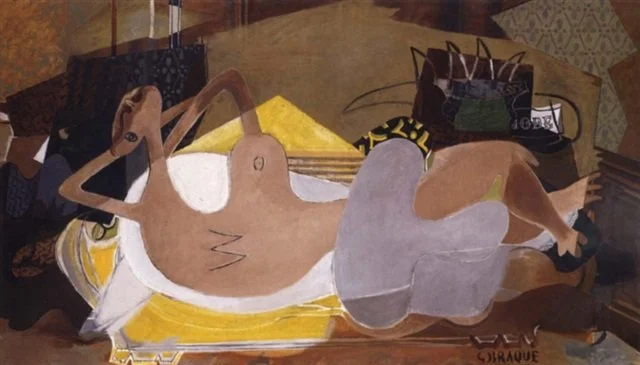GEORGES BRAQUE,
BAIGNEUSE (SUR LES GALETS), 1929
GEORGES BRAQUE
Baigneuse (sur les galets)
signed, lower right GBRAQUE
oil on canvas
8.7 x 13.8 in. / 22 x 35 cm
painted in 1929
Provenance:
● Leo Simon, New York
● Georges Renand, Paris
● Christie's London: Tuesday, December 3, 1996 [Lot 00280] Impressionist and Modern Paintings, Watercolours and Sculpture (Part II)
Exhibited:
● Paris, Musée National d’Art Moderne, Depuis Bonnard, 1957, no 54. The exhibition later travelled to Munich.
Literature:
● Cahier d’Art, 1928, rep. p. 362 (artist studio)
● Cahier d’Art, 1930, No 1, p. 10
● Cahier d’Art, 1933, Georges Braque, p. 77
● Cahier d’Art, 1935, No 1 à 4, p. 26
● Maurice Gieure, Georges Braque, Tisné (ed.) Paris 1956, rep. No 67.
● Editions Galerie Maeght, Catalogue de l’oeuvre de Georges Braque 1928–1935 Paris 1962, p. 21
● A Concise History of Modern Painting by Herbert Read, (ed.) Thames & Hudson, London 1959, p. 79
COMPARATIVE PAST AUCTIONS
-
Georges Braque, Baigneuse ll
Medium : Oil on Canvas
Year of Work : 1931
Size : Height 8.7 in.; Width 13.8 in. / Height 22 cm.; Width 35 cm.
Signed
Sale of : Christie's London: Tuesday, December 3, 1996 [Lot 00280] Impressionist and Modern Paintings, Watercolours and Sculpture (Part II)
Estimate : 35,000 - 45,000 GBP (57,471 - 73,891 USD)
Sold For : 133,500 GBP Premium (219,211 USD)
source : ARTNET.COM -
Georges Braque, Nu couché
Medium : Oil on Canvas
Year of Work : 1935
Size : Height 45 in.; Width 77 in. / Height 114.3 cm.; Width 195.6 cm.
Signed
Sale of : Sotheby's New York: Tuesday, May 13, 1997 [Lot 00035] Impressionist and Modern Art, Part I
Estimate : 800,000 - 1,000,000 USD
Sold For : 1,872,500 USD Premium
source : ARTNET.COM -
Georges Braque, Nu couché au guéridon
Medium : Oil on Canvas
Year of Work : 1931-1931
Size : Height 9.4 in.; Width 16.1 in. / Height 24 cm.; Width 41 cm.
Sale of : Christie's New York: Wednesday, November 7, 2001 [Lot 00256] Impressionist and Modern Art (Day Sale)
Estimate : 90,000 - 120,000 USD
Sold For : 182,000 USD Premium
source : ARTNET.COM
Baigneuse
Nu couché
Nu couché au guéridon
source : ARTNET.COM
DOCUMENTATION
GEORGES BRAQUE, Baigneuse (sur les galets), 1929
The use of bathers as a subject matter has been prevalent throughout the history of art. As such, Braque can be seen to be placing himself within a tradition, or ‘continuum’, here, both through his chosen medium (an oil painting) and through the classical iconography that he depicts. However, the artistic choices in this piece are strongly at odds with the type of representation seen in Classical, Academic or even simply Figurative art. Both the bather and the shapes that surround her are simplified, appearing almost geometric. Beyond a few feminine curves, she takes a very angular form, which undeniably calls Cubism to mind. In that period, bodies were depicted in fragmented and shattered fashion; here, the woman’s body seems, simultaneously, schematic and contorted.
Moreover, the white, grey, black and beige colouring points us, more specifically, in the direction of Analytical Cubism, whilst the white and black dots meant to represent the pebbles evoke the later, Synthetic period. Such dots also appear frequently in the works of Juan Gris, up until 1926. Baigneuse (sur les galets) will inevitably remind us of numerous paintings by Cézanne and Picasso, which called on the same central theme. In this era, Picasso painted Baigneuses sur la plage (Dinard, 12 August 1928), which also has comparable features.
The relationship between figure and background in this work is reminiscent of certain characteristics of Classical Art. It is the figure herself who attracts the viewer’s attention, owing to the warm colours (yellow, beige and brown) applied to her in more or less uniform, block fashion. Meanwhile, the background is made up of cooler colours (black, white and dark and light grey), creating a contrast which helps to highlight the visibility of the woman. However, that dissonance between the two does not necessarily create perspective depth: unlike in Classical Art, it looks as if the entirety of this composition exists on the same plane. That effect is accentuated by the background brush strokes (at the top of the canvas) and the very prominent use of white, grey and black to draw in the pebbles.
Although we can detect a strong link between this work and the wider history of painting – particularly through the chosen medium and central theme – the manner of its composition situates it very definitely within Modern Art.
Georges Braque’s Post Cubist Masterpieces, Anthem Edition, 2024.




